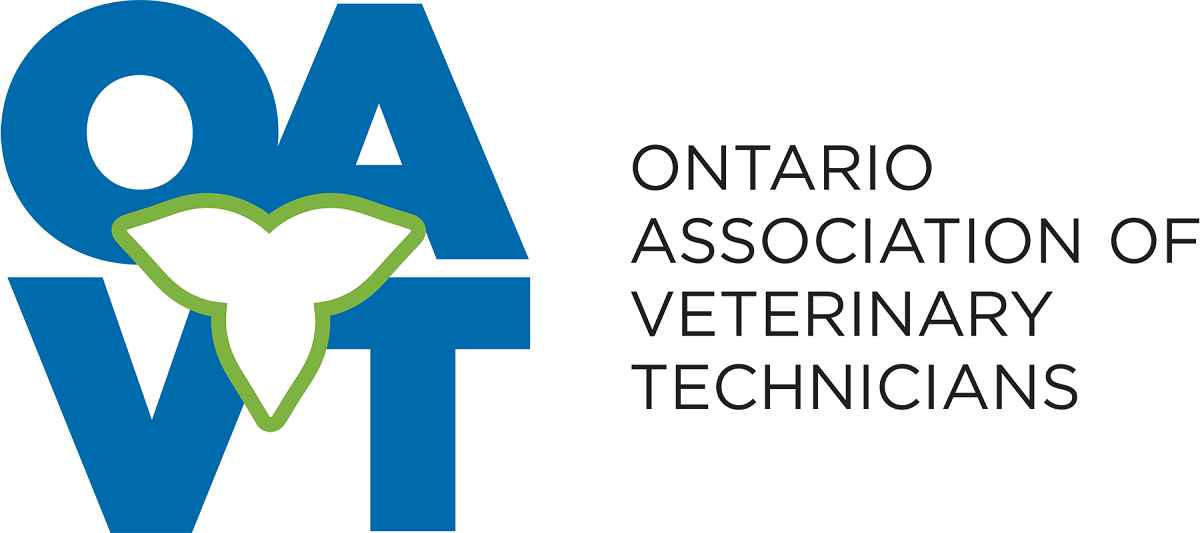ONgoing CE Opportunities
Ongoing CE Opportunities
The postings are categorized and sorted alphabetically for your convenience; they are not displayed in any order of priority or preference by OAVT. New postings are added regularly.
Table of Contents
College Programs/ Certificates/ Diplomas

This program will teach students the importance of providing an appropriate environment for a wide range of animals in both short and long term rehabilitation situations from an ecological viewpoint. The program will give students a solid foundation on wildlife rehabilitation knowledge, diagnostic and nursing skills gained through practical experience. Graduates will be able to explore a wide range of career opportunities in both the private and public sectors, including employment in natural resources, zoos, and wildlife parks, avian rehabilitation centers, natural bird sanctuaries, orphanage programs and any small or large animal veterinary clinic that receives injured wild animals. Worth 20 CE credits upon completion of program.

A graduate one-year certificate program for RVTs in response to emerging animal health care needs. Worth 20 CE credits upon completion of program
Book a seminar/Lunch & Learn or in-person course
Online Opportunities
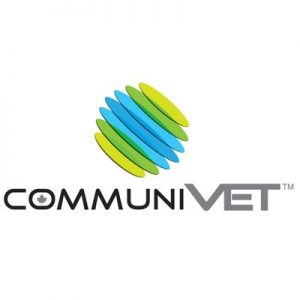
This is a 60-minute webinar. It will be available for on-demand viewing as of July 2, 2021. The link to register to this webinar is: https://www.communivet.com/en/ca/education/webinars
Objectives:
To gain an understanding of:
- Mechanisms of appetite in healthy cats
- External factors that can increase food intake in sick cats
- Medical options for appetite enhancement
Summary: How do we get a sick cat to eat? Surely, this is one of the greatest challenges in feline practice. We will discuss factors that generate appetite in cats and a multimodal approach to treating inappetent cats. Dietary and environmental modifications to increase food intake will be covered, as well as pharmacological options.


This webinar is designed to provide veterinary professionals with a better understanding of the causes, presentations, and treatment options in regard to managing acute to chronic GI upset in dogs and cats. Learn why feeding through GI upset is now recommended over the traditional recommendation of fasting, and the move away from antibiotics as treatment for GI upset. Dr. Ian Sandler introduces the products in Grey Wolf’s +GI portfolio and outlines how they are used in each stage of GI upset, and how they can be packaged together as a GI Emergency Kit to reduce unnecessary visits to the clinic and keep everyone safe. Dr. Sandler explains how the +GI products are effective in maximizing clinical outcomes and getting patients back on their paws, sooner.
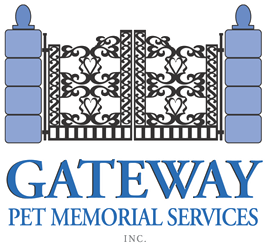
In this course, Rebecca Rose, CVT, Certified Career Coach, discusses the many stages of grieving while providing practical advice to help guide your clients through their grief.

Harnessing the power of fibre to manage diarrhea in dogs and cat
On-demand webcast available starting September 30, 2022.
Fibre supplementation can be a powerful tool—when used correctly. Join Dr. Valerie Parker in this webinar as she discusses how to quantify fibre and shares different situations in which fibre supplementation may prove useful in controlling stool quality.
https://www.communivet.com/en/ca/education/webcasts/power-of-fibre-to-manage-diarrhea
OAVT – 1 CE credit

Help! My puppy or kitten is scratching
There is a common misconception that food allergies cause skin problems in pets. However, these types of allergies are actually quite rare. In fact, environmental allergies are the most common cause of allergies in pets.
During this webcast, dermatology specialist Dr. Gabrielle Brosseau will discuss food and environmental allergies, as well as parasitic, viral, bacterial, fungal, inflammatory, and autoimmune dermatoses, which especially affect puppies and kittens.
Presented by Gabrielle Brosseau, DVM, IPSAV, Dipl. ACVD
This webcast will be presented in French with simultaneous interpretation in English, so the PPT presentation is in French.
OAVT – 1 CE credit

We all love senior pets! Graying bodies, and sweet expressions of long term devotion, and experiences. As animals, including humans, age, their energy requirements along with how effective the body utilizes that energy changes. Looking beyond the gray hairs, what do we need to consider when determining an appropriate diet for senior pets? What nutrients should the calories come from? When looking at a bag of food, how can I determine if it’s meant for a senior pet? Once we understand some of the ins and outs of senior nutrition, how do we instill the value of senior nutrition in our pet parents? This interactive session will use some real life examples to help guide you through the nutrition journey with a pet and the pet parent.
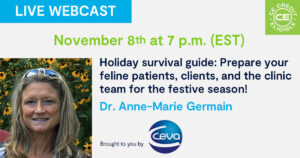
Presented by Dr. Anne-Marie Germain
The holiday season can be stressful for cats, pet owners, and the entire veterinary team. Last-minute “urgent” requests from anxious pet owners for medication, food, or in need of an appointment for their sick cats, vomiting, urinating outside the litter box, or even worse, with a possible urinary obstruction. Sounds familiar?
During this webcast, Dr. Anne-Marie Germain will share some helpful ideas, practical clinic tools, and sound bites designed to help cat owners better understand cats, help them optimize the environment to decrease stressors for their feline friends, avoid some mishaps, and be more prepared to help everyone enjoy a festive holiday season.

Knowledge and skill of the veterinary professional are instrumental to the successful outcome of any dental procedure. A third and often overlooked contributing factor to a successful procedure is the instrumentation and equipment used. Not only is the appropriate selection and correct use of dental instrumentation and equipment important, the care and maintenance they receive greatly impacts their effectiveness. Well maintained, sharp, dental hand instruments enable the veterinary professional to complete the procedure at hand more efficiently, with less trauma to the patient. This video will address sharpening materials needed, differences between scalers and curettes, how to sharpen luxators, elevators, root tip picks, periosteal elevators, scalers and curettes, as well as how to do minor repairs on damaged and/or misshapen instruments. This video is suitable for veterinarians, registered veterinary technicians and other practice staff.
The tutorial will be available here: https://www.communivet.com/en/ca/toolbox/2022/how-to-best-sharpen-your-dental-instruments.

How to incorporate a complete dental examination and diagnostic dental radiographs into your practice
During this webcast, Dr. Leah Limone will review how to complete a thorough oral/dental examination. She will also explore normal vs abnormal anatomy, and go over radiographic views to take to help diagnose areas of dental disease.
To register: https://www.communivet.com/
OAVT Credits – 1 CEC

This is a 60-minute webinar. To watch: https://www.communivet.com/en/ca/education/webcasts/incorporating-benzodiazepines-into-your-anesthesia-practice
During this webcast, Dr. Jessica Pang will discuss the challenges related to deciding when and how to use benzodiazepines in daily practice. She will also provide guidelines on the following aspects:
- how to take advantage of the physiologic effects of midazolam and diazepam; and,
- how to incorporate them into sedation and anesthesia protocols for small animal patients.

https://www.communivet.com/en/ca/education/webcasts/individualized-nutrition
Presented by Dr. Erico Ribeiro
Individualized nutrition
• Review of the essential factors for providing individualized nutrition for healthy dogs and cats and during times of disease
• Demonstration of examples of cases and calculations
• Discussion on when supplementation is required and how to dose correctly

This presentation will help you understand the intestinal microbiota in health and disease (with focus on acute diarrhea and chronic intestinal inflammation), the methods for evaluation of the intestinal microbiota, and how therapeutic manipulation (antibiotics, probiotics, diet, fecal microbiota transplantation) can help in the management of chronic enteropathies. Presented by Jan Suchodolski, DrMedVet, PhD, AGAF, Dipl. ACVM

It’s not just “chonk”! Taking obesity and overweightness seriously in cats and dogs
- Review of the broad impacts of obesity and overweightness on cats and dogs as they age
- Review of current research on obesity communication, with an emphasis on the challenges we must overcome as veterinary teams
- Discussion of effective strategies to support conversations with pet owners, including open‐ended questions and nutritional history forms
OAVT CE Credit – 1

Learn how to create a business culture that fosters a high level of employee engagement
As you know, we have a severe shortage of veterinarians and support staff in our profession. While we tend to focus on attracting people to the veterinary profession, the bigger issue is that we have a retention problem. Disengaged employees are a cause of low morale, productivity and profitability; and increased employee turnover, burnout and client complaints. One key to retaining employees is to create a business culture that has a high level of employee engagement. A standardized employee engagement survey can provide a business with key insights on employee satisfaction which can then be the basis for organizational changes that can lead to increased practice productivity, profitability and client loyalty… with happier and more motivated employees.
The presentation is being delivered on two dates – February 21st from 8 a.m.-9:15 a.m., and February 28th from 10 a.m.-11:15 a.m.
Presented by Dr. Mike Pownall
OAVT CE – 1.25 credits

Managing castration complications in the field
Castration remains one of the most stressful procedures for many field veterinarians. Dr. Doyle takes us through how to deal with both major and minor complications of equine castration in the field in this one hour presentation.
Presented by Dr. Aimie Doyle
OAVT CE – 1 credit

Presenter: Daniel Harvey, CMDRT, RVT, AHT, LAT, N
Course Description: This course covers the basics of medical device reprocessing, i.e. cleaning, disinfection, decontamination, and sterilization of surgical instruments. The syllabus is composed of 26 chapters with discussion groups and a graded quiz for each chapter. The instructor will personally monitor the discussion groups daily, to ensure your learning.

Mental wellbeing at work: What you can do for yourself and your team
By midlife, approximately 50% of adults will have or have had a mental illness. Mental health is something that all individuals have and it exists on a continuum ranging from excelling to in crisis. Given the stressors that veterinary teams experience and their susceptibility to psychological distress, strategies for thriving mental health are necessary.
During this webcast, veterinary wellness advocate and Thrive! collaborator, Dr. Marie Holowaychuk will share her expertise and provide insight on the following elements:
• Statistics regarding mental health and psychological distress among veterinary team members.
• The mental health continuum and how to recognize mental health problems in yourself and other team members.
• Tools and tips for fostering mental health and wellbeing as an individual or leader in your workplace.
OAVT Credit: 1 CEC

Presented by Darren Osborne, Dr. Anie Levesque, Dr. Bill Saxon and Dr. Jason Gagné. (This 120-minute webcast is available for on-demand streaming, via the web portal CommuniVET.com.) In this presentation, learn how marketing, senior wellness testing and nutrition combined can benefit your patients and clinic with four leading experts in the field. Accredited for 2 CE credits.
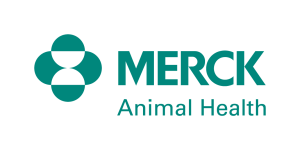
National Tick Awareness Month 2022: One Health, ticks and Lyme disease
As part of National Tick Awareness Month, Dr. Clow, Dr. Stevenson and Dr. Yabsley engage in an informative discussion about the concept of One Health and how veterinarians play an essential role in helping to protect, monitor and manage tick-borne diseases like Lyme disease in pets and people.
The recorded webinar will be available on-demand until March 2023. Participants must complete a series of 6 questions and answer successfully in order to get their CE certificate. OAVT members will earn 0.5 credits for successful completion of the quiz.
To watch the webinar: https://onlinexperiences.com/scripts/Server.nxp?LASCmd=AI:4;F:QS!10100&ShowUUID=0C907194-68A4-4BCE-AAFC-9B3BCCEAA1D6&LangLocaleID=1033

Presented by Dr. Janice Huntingford
Non-steroidal anti-inflammatory drugs (NSAIDs) are commonly used to treat osteoarthritis (OA) pain, inflammation, and stiffness. With recent advances in treatment, more options are available to provide affected pets with relief from symptoms and greater mobility, thereby improving their quality of life.
PART 1: NEW AND NOVEL TREATMENTS FOR DJD
Most veterinarians would agree that 80% of dogs over 8 years of age have osteoarthritis (OA) when, in fact, most OA is conformational in origin and is often preclinical in at-risk patients. In reality, over half of all dogs are not diagnosed with degenerative joint disease (DJD) until they are approaching end of life. Dr. Janice Huntingford will focus on early diagnosis of DJD, the importance of multimodal therapy, and some of the newer and novel treatments for DJD, including monoclonal antibodies, nutraceuticals, and rehabilitation.

Watch this webinar to learn about how you can future-proof your clinic’s small animal parasite protocols. In this session, parasitologist Prof. Christopher Fernandez-Prada will: Provide an overview of the new Canadian Parasitology Expert Panel (CPEP) guidelines; Highlight a few emerging parasitic threats, such as the Echinococcus tapeworm, that have been the focus of several recently published scientific studies; and Examine the importance of proper diagnosis and current prevention protocols for your patients.

Intestinal parasites have been detected by many different test methods over the years. Some outdated tests performed in‐house are not nearly as sensitive as newer techniques have been. PCR to identify DNA and RNA from parasites is a new modality that not only more effectively identifies the exact parasite present, it gives the clinician more information about the parasite, allowing for better management of the patient. This talk will review a new fecal PCR panel and highlight the benefits for the clinician and the patient of this next level of testing.
Link to watch on-demand version (available as of March 16, 2022): https://www.communivet.com/en/ca/education/webcasts/next-level-intestinal-parasite-detection

Presented by Dr. Ebenezer Satyaraj. Allergies to cats are the most common animal‐origin allergy, and affect about 1 in 5 adults worldwide. While cats produce several allergens, more 96% of people with sensitivities to cat respond to the primary cat allergen, Fel d1, a protein secreted in the saliva and sebaceous secretions of the cat. Allergen avoidance is the most effective solution; it however involves limiting interaction with the cat or in some cases relinquishing the cat. There is a need for innovative approaches to manage cat allergens. We will discuss the scientific basis of a novel approach to simply, safely and effectively neutralize Fel d, the most potent feline allergen, utilizing an anti‐Fel d1 IgY antibodies (derived from chicken egg) added to cat diet.

Nutritional management of osteoarthritis
Review of the role of nutrition in the management of patients with osteoarthritis: patient assessment, key nutritional factors and nutraceuticals.
OAVT CE Credit – 1
